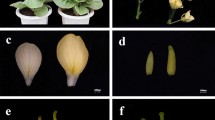Abstract
Polyploidy has long been recognized as a prominent force shaping the evolution of flowering plants. However, the causes of novel variation in polyploids are not well understood. Therefore, a comprehensive survey of global gene expression in response to polyploidy was performed by using anArabidopsis thaliana whole genome Affymetrix gene chip (ATH1) to quantify the variations in transcript abundance of 22,810 genes between autotetraploid and diploidIsatis indigotica Fort., which is the same family, Cruciferae, asArabidopsis thaliana. The analysis revealed a coordinated induction and suppression of 715 and 251 ploidy-responsive genes in autotetraploidIsatis indigotica Fort., respectively. The functional classification of some of these up-regulated genes indicates their involvement in various metabolic, signal transduction, transcriptional regulation, and developmental pathways. The results enhance our knowledge about molecular processes associated with autopolyploidy.
Similar content being viewed by others
Abbreviations
- GAPDH:
-
glyseraldehyde-3-phosphate dehydrogenase
- GCOS:
-
GeneChip Operating Software
- IVT:
-
in vitro transcription reaction
- LBRG:
-
lignin biosynthesis related gene
- RLK:
-
receptor-like kinase
- STG:
-
signal transduction gene
- TF:
-
transcriptional factor
References
Adams KL, Cronn R, Percifield R and Wendel JF (2003) Genes duplicated by polyploidy show unequal contributions to the, transcriptome and organ-specific reciprocal silencing. Proc Natl Acad Sci USA 100: 4649–4654.
Adams KL and Wendel JF (2005) Polyploidy and genome evolution in plants. Curr Opin Plant Biol 8: 135–141.
Blanc G and Wolfe KH (2004) Functional divergence of duplicated genes formed by polyploidy during Arabidopsis evolution. Plant Cell 16: 1679–1691.
Galitski T, Saldanha AJ, Styles CA, Lander ES and Fink GR (1999) Ploidy regulation of gene expression. Science 285: 251–254.
Gaut BS and Doebley JF (1997). DNA sequence evidence for the segmental allotetraploid origin of maize. Proc Natl Acad Sci USA 94: 6809–6814.
Guo M, Davis D and Birchler JA (1996) Dosage effects on, gene expression in a maize ploidy series. Genetics 142: 1349–1355.
Han FP, Fedak G, Ouellet T and Liu B (2003) Rapid genomic changes in interspecific and intergeneric hybrids and allopolyploids of Triticeae. Genome 46: 716–723.
Humphreys JM and Chapple C (2002) Rewriting the lignin roadmap. Curr Opin Plant Biol 5: 224–229.
Kashkush K, Feldman M and Levy AA (2003) Transcriptional activation of retrotransposons alters the expression of adjacent genes in wheat. Nat Genet 33: 102–106.
Lagercrantz U and Lydiate DJ (1996) Comparative genome mapping inBrassica. Genetics 144: 1903–1910.
Lee HS and Chen ZJ (2001) Protein-coding genes are epigenetically regulated in Arabidopsis polyploids. Proc Natl Acad Sci USA 98: 6753–6758.
Levin DA (1983) Polyploidy and novelty in flowering plants. Am Nat 122: 1–25.
Liu B and Wendel JF (2003) Epigenetic phenomena and the evolution of plant allopoly-ploids. Mol Phylogenet Evol 29: 365–379.
Madlung A, Masuelli RW, Watson B, Reynolds SH, Davison J and Comai L (2002) Remodeling of DNA methylation and phenotypic and transcriptional changes in synthetic Arabidopsis allotetraploids. Plant Physiol 129: 733–746.
Morris ER and Walker JC (2003) Receptor-like protein kinases: the key to response. Curr Opin Plant Biol 6: 339–342.
Pires JC, Zhao J, Schranz ME, Leon EJ, Quijada PA, Lukens L and Osborn TC (2004), Flowering time divergence and genomic rearrangements in resynthesized Brassica polyploids (Brassicaceae). Biol J Linnean Soc 82: 675–688.
Qiao CZ, Wu MS, Dai FB, Cui X and Li L (1989) Studies on polyploid breeding ofIsatis indigotica Fort. Acta Botanica Sinica 31: 678–683.
Ramsey J and Schemske DW (2002) Neopolyploidy in flowering plants. Annu Rev Ecol Syst 33: 589–639.
Schena M, Shalon D, Davis RW and Brown PO (1995) Quantitative monitoring of gene expression patterns with a complementary DNA microarray. Science 270: 467–470.
Schranz ME and Osborn TC (2000) Novel flowering time variation in the resynthesized polyploidBrassica napus. J Hered 91: 242–246.
Shiu S-H and Bleecker A (2001) Plant receptor-like kinase gene family: diversity, function and signaling. Science's STKE 113: 1–13.
Shoemaker RC, Polzin K, Labate J, Specht J, Brummer EC, Olson T, Young N, Concibido V, Wilcox J, Tamulonis JP, Kochert G and Boerma HR (1996) Genome duplication in soybean (Glycine subgenus soja). Genetics 144: 329–338.
Soltis DE and Soltis, PS (1995) The dynamic nature of polyploid genomes. Proc Natl Acad Sci USA 92: 8089–8091.
Wendel JF (2000) Genome evolution in polyploids. Plant Mol Biol 42: 225–249.
Wu P, Ma LG, Hou XL, Wang MY, Wu YR, Liu FY and Deng XW (2003) Phosphate starvation triggers distinct alterations of genome expression in Arabidopsis roots and leaves. Plant Physiol 132: 1260–1271.
Zhao J, Davis LC and Verpoorte R (2005) Elicitor signal transduction leading to production of plant secondary metabolites. Biotechnol Adv 23: 283–333.
Author information
Authors and Affiliations
Corresponding author
Additional information
These authors contributed equally to this work
Rights and permissions
About this article
Cite this article
Lu, B., Pan, X., Zhang, L. et al. A genome-wide comparison of genes responsive to autopolyploidy inIsatis indigotica usingArabidopsis thaliana Affymetrix genechips. Plant Mol Biol Rep 24, 197–204 (2006). https://doi.org/10.1007/BF02914058
Issue Date:
DOI: https://doi.org/10.1007/BF02914058




